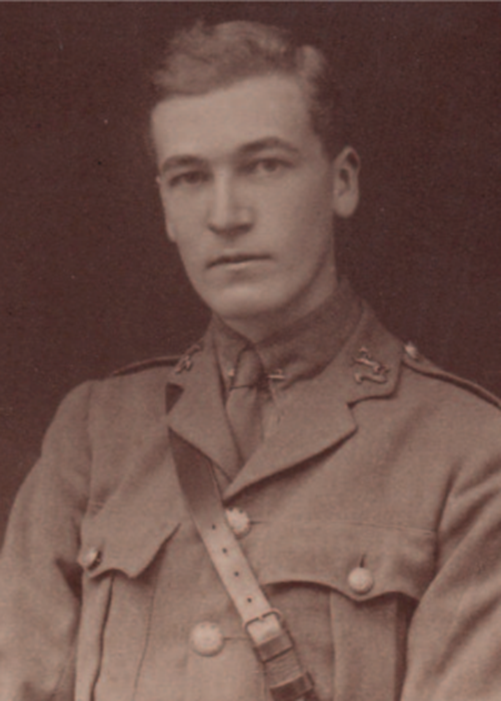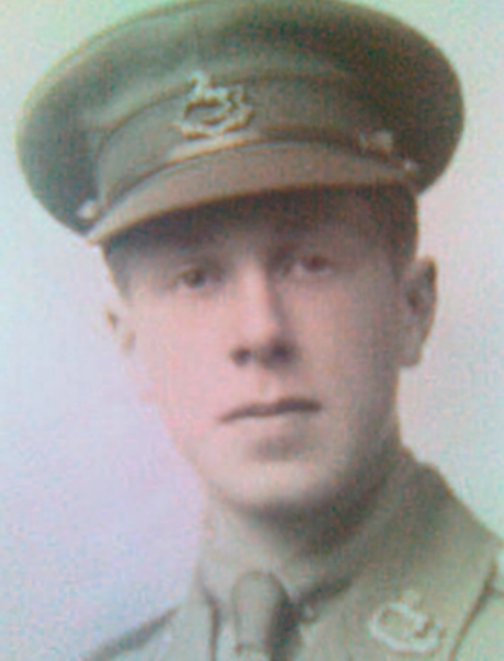'The Grave by the Roadside' : Remembering 2/Lt. H G Thorpe who died 24 March 1918
- Home
- World War I Articles
- 'The Grave by the Roadside' : Remembering 2/Lt. H G Thorpe who died 24 March 1918
One of the illustrated WFA talks ('Six Months with the King’s (Liverpool) 1917-1918’) I’ve given over the last twenty years or so tells the story of my uncle, 2/Lt H G Thorpe MC, 1/King’s Liverpool Regt, who was killed in action on 24 March 1918. Members who have heard it might be interested in a recent development.

Gordon Thorpe’s is a remarkable story and I am fortunate in the amount of detail in public records. The War Diary appendices, for example, include both the detailed orders and reports of the three trench raids he led culminating in his immediate award of the Military Cross on 12 March 1918. But only twelve days later, in the March Retreat, Gordon Thorpe was posted missing.
It is his death and what happened afterwards which concerns us here. Almost nineteen months later in October 1919, my grandfather went to France, found Gordon’s grave, identified him and had his body taken to Bancourt British Cemetery. How did he do it? My talk tries to answer these questions.
My grandfather died in 1927 and whilst his own papers have not survived I do have copies of his correspondence with the War Office and IWGC and a mass of other information to tell most of the story. I say 'most' because there has always been a very slight doubt in my mind about his identifying the body. Let me explain.
Following the German attack on 21 March, the King’s were in action to the east of Bapaume astride the Haplincourt-Bertincourt road. Gordon Thorpe was last seen on the Green Line to the east of Haplincourt having been twice wounded earlier in the day. After the position was overrun, the King’s and the rest of 6 Brigade reformed on the improvised Red Line over a mile further back behind Haplincourt before retreating across the old Somme battlefields. The grave, dug by the Germans for “Ein Englischer Officer Drei Men”, was found on the south side of the road “a little way from the front line trench our brave boy had held to the last”. The “grave had been carefully kept later by our own soldiers ... his body was most carefully taken out by a party of our men” wrote my grandfather to Gordon’s fiancé.
By the end of the war the graves of four of the six officers of 1/King’s lost on 24 March had been identified. But two officers were unaccounted for. Both wore the single pip of a second lieutenant and both wore the ribbon of the Military Cross. They were HG Thorpe and RS Tarran.

Bearing in mind how long the body had been in the ground and the dreadful task of trying to identify his own son, how could my grandfather be certain he had really found him and not 2/Lt Tarran? There was other evidence to help identify Gordon but in my talk I always say that conclusive evidence - for example, eye witness reports that Tarran was seen elsewhere, might well have been available to my grandfather if not to me.
And then on the 90th anniversary of the action, 24 March 2008, the following announcement appeared in the Daily Telegraph:-
“TARRAN – 2/Lt Reginald S. MC 1st Batt. King’s (Liverpool) Regt., kia near Haplincourt Wood, France March 24 1918. Fondly Remembered.”
Well, if this was right, if Tarran really was killed near Haplincourt Wood, he was way behind the Green Line and could not have been the officer in the roadside grave. Was this the proof I had been seeking? And why hadn’t I thought of placing such an announcement years ago!
I lost no time in contacting Tarran’s family who responded immediately for they too had tried to discover what had happened. I am extremely grateful to 2/Lt Tarran’s niece Ann, and her husband Dr Robin Agnew for the photograph and information they so kindly sent me.
In fact, Tarran’s father had tried just as hard as my grandfather but, alas, had not found his son who is remembered on the Arras Memorial to the Missing. But he did obtain two eye witness reports confirming that Tarran was killed in the shelling which decimated ‘C’ Company on the morning of 24 March on the Green Line. So he was not killed near Haplincourt Wood.
This seemed to make matters worse. Tarran was killed to the north of the Haplincourt-Bertincourt road and Thorpe to the south of it a few hours later – probably about 350 yards away with the grave roughly in the middle. On this evidence the roadside grave could have contained either one of them! (The understandably sketchy war diary of the retreat is hardly precise and I have never found any good maps of these actions. I made my own from aerial photographs and an earlier trench map - so it is not surprising that the position given to Tarran’s descendants was wrong by a mile or so.)
But once this disappointment was out of the way it became obvious that there was more to it. It seems that both fathers were in touch with 1/King’s CO, Lt Col David Murray-Lyon and his staff. Both researched along much the same lines at much the same time and it seems inconceivable that they, the occupying troops and certainly the King’s, were unaware of the possibilities of the grave by the roadside. And yet, apparently, all were satisfied with the outcome and my grandfather’s evidence was accepted as proof by the Imperial War Graves Commission.
Knowing all this tends to confirm that my grandfather really did have no doubt in his mind when he wrote to his son’s fiancé “I am quite certain it was dear Gordon”.
Barrie Thorpe
This article first appeared in the 90th Anniversary Edition 1918-2008 October/November 2008 of the member and inhouse magazine Bulletin.





